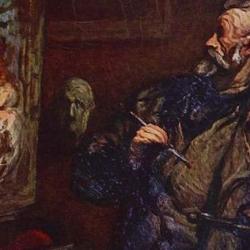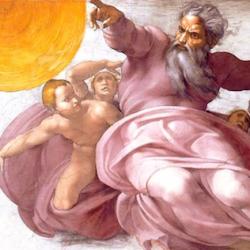Karol Berger (A Theory of Art) states the common observation that “autonomy is widely seen today, especially among theorists and historians of a sociological bent, as the single most important feature distinguishing modern from premodern art.” In the ancient and medieval worlds,
art was embedded within a wider sphere of social practices and derived its significance from them. It was predominantly heteronomous, since the goods it pursued were not internal to the artistic practices themselves. Instead, art served the goals of the principal social institutions: the church and the state, the guilds and corporations of the civil society, the family.
Aesthetics, reflection on the nature and uses of art, wasn’t a distinguishable arena of philosophy since in that social setting “the question of art’s function, or rather functions, was not at issue.” By contrast, modern art aims to be autonomous, insisting that “the goals of its producers are internal to the practices of the various arts themselves, and not imposed on them from without.” This is the situation that keeps philosophers like Berger in business, asking the question, “What is the function of functionless art?”
Berger fills in the picture by referring to Norbert Elias’s work on Mozart, whom he uses to exemplify the shift from “craftsmen’s art” to “artists’ art.” The shift isn’t simply within the world of art, but has to do with art’s place within society, and with the shape of the society within which art is placed. For premodern consumers, art was
a function of other social activities of the consumers. In particular, it was an aspect of the competitive spending on status. Since art was created for specific social functions, not the least of which was the society’s self-display, the patrons were not individualized, but rather represented social groups.
The modern artist doesn’t work for a patron but produces works for a “market of anonymous buyers,” buyers who are often of a similar social and economic status with the artist. Modern artists do not address groups or patrons, but “a public of isolated individuals, and its function is specifically aesthetic.” Elias claims that this change occurred as a result of the “social ascent of a wealthy middle class, in the displacement of the court aristocracy by the professional bourgeois public as the upper class.” Status competition is still at work, but the fluidity of social life leaves the artist with some leverage, and the capacity not only to reflect taste but to make it.
In short, modernity
changes the balance of power between the artist and patron in favor of the former.” Berger elaborates: “Once an artist stops working for a specific patron (a church, a court) and offers his products for sale to patrons whose identities cannot be fully specified in advance, that is, once he begins to function within the market, he may be better able to produce works that embody his, rather than his patrons’, values, thereby increasing his autonomy (even if in practice this autonomy is frequently undermined by the increased economic insecurity).
Berger recognizes that this “modernizing” of the art world didn’t happen simultaneously everywhere or in every artistic field:
in German-speaking lands, for instance, it occurred much earlier in literature (and philosophy) than in music or architecture. The development of the market for books that allowed a writer a freelance existence, however precarious, preceded by decades the development of comparable market institutions—such as music publishing, copyright, or public concerts—for music.
The social changes that affect the artist’s audience also affect the public’s expectations of artists and of art. Coming from autonomous artists producing works for the market of anonymous individuals, art is expected to be original and innovative, just like everything else on the market.
This has some lessons for those disturbed by the trends of contemporary art. Berger’s analysis implies that it’s not enough to exhort artists to make differently. The social and economic setting of modern art has to be rethought. The cause of art might be best served by a revival of patronage.















